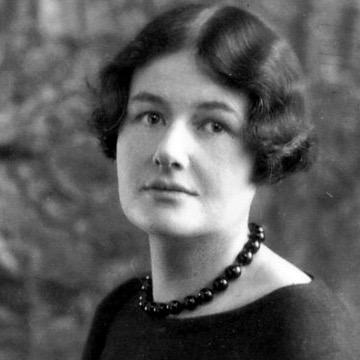
Rebecca Clarke

Born to a musical family in Harrow, England, in 1886, Clarke was taught the violin at an early age, and then sent for further study at the Royal Academy of Music, in London. In 1908, she went to the Royal College of Music as one of Sir Charles Stanford’s first female composition students. Stanford urged her to shift over to the viola because then she would be “right in the middle of the sound, and can tell how it’s all done.” Two years later, after she quarreled with her father and had to leave the College, she began to support herself as a violist. She became a much-sought-after supply player in orchestras and ensembles around London, and played chamber music with many of the greatest artists of the early twentieth century, including Schnabel, Casals, Heifetz, Thibaud, Suggia, Rubinstein, Grainger, Hess, Monteux, and Szell. She stood nearly six feet tall in her prime and, as one witness put it, “she strode on stage like a goddess.” Rubinstein called her “the glorious Rebecca Clarke.”
She was one of the first women to be made regular members of a professional orchestra in London, in 1913, when Sir Henry Wood hired her for his Queen’s Hall Orchestra. She performed throughout Great Britain, Europe, and the United States, and made a round-the-world tour, as a self-styled “viola player and composer.” As a performer, and as a pioneering advocate for the viola, she was on a par with Tertis and Primrose. As an apostle of chamber music, she far outstripped them.
During her first American tour, she wrote one of the greatest extended works for viola, her Sonata of 1919, which she entered in an anonymous competition sponsored by the renowned American patron Elizabeth Sprague Coolidge. The judges deadlocked over two submissions: one, they said, was the work of a philosopher, the other that of a poet. Mrs. Coolidge cast the deciding vote in favor of the philosopher, and when the seal was broken the winning piece turned out to be Ernest Bloch’s Suite. But the judges were so taken with the other piece that they insisted on bending the rules and revealing its composer as well, and, as Mrs. Coolidge told Clarke later that afternoon, “You should have seen their faces when they saw it was by a woman.” (Word soon got out that at least some of them had thought it was by Ravel.)
Almost overnight, Clarke became an international sensation, and she made the most of it, barnstorming the Sonata so assiduously, on both sides of the Atlantic, that Lionel Tertis raced to perform it, and J. & W. Chester published it two years later. As time went by, Clarke racked up a solid list of publications with Chester, Winthrop Rogers (later part of Boosey & Hawkes), Oxford University Press, and G. Schirmer. Her compositional output was small—about eighty pieces, if you exclude those she wrote as an untutored amateur—but it comprised some of the most brilliant and powerful songs and chamber works of the twentieth century. The Sonata became a cornerstone of the viola literature, the Piano Trio of 1921 was widely played and nowadays is considered a masterpiece, and by 1925 Clarke’s place among “the élite of musicians” (Morning Post) was so firmly established that she could sell out London’s Wigmore Hall with a concert made up entirely of her own compositions, and then repeat most of the program in a live broadcast from the studios of the BBC.
In time, Clarke earned substantial entries in all of the standard musical and musicological references, many of which carried lists of her works, published and unpublished. But the Clarke women are extraordinarily long-lived, and time exacted its price. Clarke’s career was disrupted by World War II, and her essentially tonal compositions, which began to seem “old hat,” as she put it, after the postwar triumph of academic serialism, gradually drifted out of the limelight and went out of print. But Clarke’s music was so wonderful, and her personality so attractive, that both were ideally positioned for a revival in the 1970s, when tonality again became thinkable, when a resurgent feminist movement began to stir up new interest in women composers, and when Clarke finally gave in to pleas from some of the younger members of her family and allowed her music to be organized and catalogued. By the time Clarke died, in 1979, she had enjoyed several major New York performances—her first in nearly thirty years—and an extended ninetieth-birthday broadcast. The following year saw the release of the first in what was to become a spate of commercial recordings, and by 1987, Clarke was being acknowledged, not only as “one of the very best [composers] of her time,” but as “almost certainly the best composer of any period to have also been a woman” (Malcolm MacDonald, review of Rebecca Clarke: Music for Viola, Northeastern NR215, Gramophone 64/765, February 1987).



